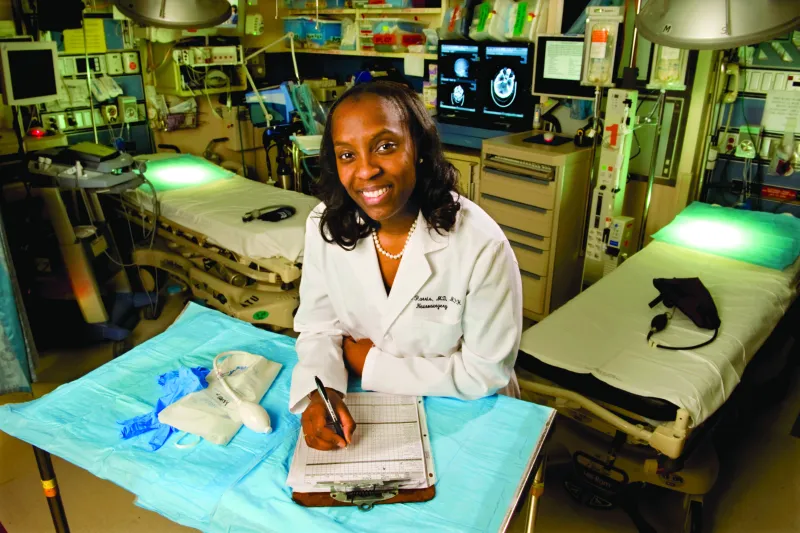Dr. Odette Harris M.D. ’96 was worn out. Lunchtime was nearing. The national surgical conference she was attending had been in full swing in a hotel conference room since 7 a.m.
Harris, who had been sitting at a table with everyone else and engaging in the discourse, decided it was time to stretch her legs. She walked to the back of the room and saw one of the attendees — who had just been at the table with her — approach her.
He launched into a series of instructions about how to set up lunch, assuming that she was a member of the waitstaff. Shock flooded Harris’ mind at the biting realization that she, like so many women of color, was invisible to those around her.
“I’m at the table,” she told him. “I’m not making the table.”
Today, Harris is a professor of neurosurgery at the Stanford School of Medicine, the director of the Brain Injury Program and the neurosurgery department’s vice chair of diversity, where she is working to expand equity and inclusion at one of the nation’s most elite medical schools.
As the United States’ second Black female professor of neurosurgery, she is all too familiar with the barriers to success that women of color encounter.
While women make up about 9% of practicing neurosurgeons in the United States, women identifying as Black or African American represent 0.585% — or just 33 neurosurgeons nationwide.
“It’s like you’re walking uphill with weights on and competing with a person who’s going downhill,” she said in an interview with The Daily.
‘Without hope, why bother, right?’
Harris moved to the U.S. from Jamaica as a young girl, and the challenges that came with a lack of cultural understanding became apparent to her early on. She still remembers a placement test she took that determined which grade she would enter when starting school in the U.S.
She ended up failing the test — not because she lacked ability or knowledge, but because the test itself was culturally insensitive, “and perhaps not intentionally so,” she said. It asked questions like, “What’s a nickel plus a dime?”
Harris was unable to answer the question, not because she did not know how to add, but because she was not yet familiar with American currency. “There were many questions like that,” she said.
Her parents’ advocacy led the test administrators to realize that Harris’ performance was not reflective of her knowledge. After she was given a new exam, she passed with flying colors.
But this cultural insensitivity would later morph into race and gender-based discrimination.
Her husband jokes that her autobiography should be titled, “No, I’m Not From Maryland.” People found it easier to believe that the M.D. after her name was an abbreviation for the state of Maryland rather than her hard-earned degree.
“The leap that a Black woman could be a doctor is so great that they would rather believe that people walk around with their geography next to their name,” she said.
Despite stories like this, she chooses to hope that some crucial change will arrive. “Without hope, why bother, right?” she asked.
It’s her unwavering strength that one of her former co-residents credits for allowing her to overcome each barrier she has faced. Dr. Samuel H. Cheshier, who directs pediatric surgical neuro-oncology at the University of Utah School of Medicine, said that Harris never stops to consider a hurdle as insurmountable.
Instead, he said, she plows on with what she originally set out to do. “She will move forward with her plan, and feel strongly about it, and not have any self-doubt at all.”
Harris credits her success in part to her strong support system. She keenly remembers her time at an all-girls school in the U.S. and said the atmosphere there bolstered her view that opportunities for women are limitless.
At a time when science and math were nearly male-dominated fields, she was being taught those subjects by nuns. “Who else was going to teach science if not a woman? Teach basketball if not a woman?”
Her belief that she could accomplish anything she set her mind to is clearest in her career ambitions at a young age. She wanted to become everything from a pediatrician to an accountant.
While her time at Dartmouth College was a jolt compared to what she was used to, it was there that she first stumbled upon neuroscience. She found the first class she ever took in the field to be “absolutely fascinating.”
At the Stanford School of Medicine, Harris was the only Black woman in her class. And during her neurosurgery residency at Stanford Medical Center, she was just one of two female residents.
But, she said she always felt supported by her colleagues, even though she stuck out in the crowd. A few years into her residency, Harris was named chief resident. And as a 5-foot-2-inch Black woman surrounded by 6-foot tall male residents, her role was often met with disbelief.
“My colleagues would just be like, ‘Actually, she’s the boss,’ and advocated and supported in ways that really strengthened our bond,” she said.
Harris added that Stanford is a “unique place” because of the faculty support she experienced, propelling her to success. That environment extended to her co-residents.
“We were a clan, a family,” she said. “We were all invested in each other’s success.”
Harris is a “force of nature,” wrote Dr. John Adler, an emeritus professor of neurosurgery.
“Dr. Harris’ leadership and communication skills make her stand out in medicine,” he wrote. “She perfectly blends intellect, personality, and ambition, making her a pleasure to mentor.”
For Harris, each conversation always circles back to hope, especially in the context of movements like Black Lives Matter.
“When you work with kids, as an educator in an academic setting, the hope you see in their eyes is awesome,” she said. “Whether or not that hope translates into difference is yet to be seen.”
